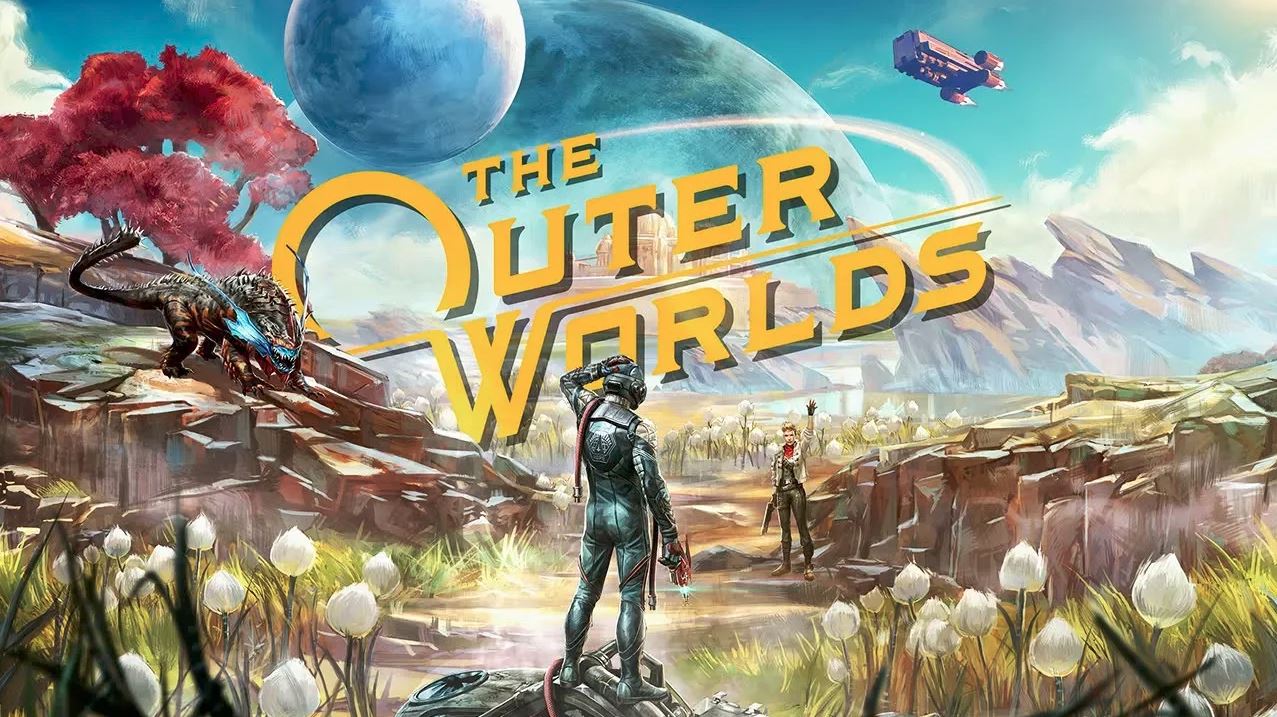
Obsidian has been responsible for a number of beloved RPGs over the years, but I think its safe to say that the game most people remember them for is Fallout: New Vegas. Any online debate about the Fallout series is sure to draw in scores of gamers proclaiming that New Vegas is the best game in the franchise. Of course, deep down we all know that they are factually wrong since Fallout 2 is the best one, but that’s a discussion for another time. What’s undeniable is that many people have been hoping that Bethesda would give Obsidian another shot at the Fallout license, especially after Fallout 4 and Fallout 76. Since it seems unlikely that Bethesda will ever cave to these demands, Obsidian took it upon themselves to make The Outer Worlds. This newest first-person RPG from the fan favorite company is easily described as “Fallout: New Vegas in space, with a dash of Firefly.” While that description isn’t completely inaccurate, I have to admit that this isn’t exactly the grand return that many fans were probably hoping for.
The Outer Worlds
Publisher: Private Division
Developer: Obsidian Entertainment
Platforms: Windows PC, PS4 (Reviewed), Xbox One
Release Date: October 25th, 2019
Players: 1
Price: $59.99
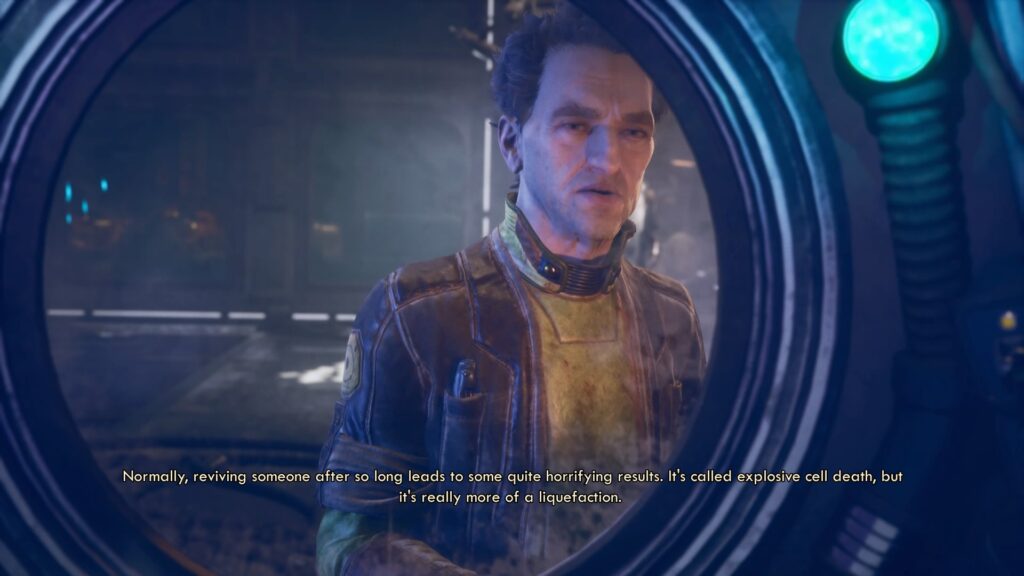
The Outer Worlds is set in the Halcyon colonies, on the edge of known space. You are one of many aspiring frontiersmen in cryosleep onboard the Hope colony ship, determined to build a new life in uncharted territory. At least, that was the plan.
Upon being awakened by the eccentric Phineas Welles, you learn that a malfunction in the Hope‘s skip drive made the ship enter real space on its journey to Halcyon. In other words, you’ve arrived over 70 years late to the party. The Halcyon colonies have long since been established and divvied up by ruthless and hilariously oppressive megacorporations with questionable views on workers’ rights and product safety.
Should you choose to go along with Welles, your overarching goal will be trying to get the resources he needs to reawaken all the rest of Hope‘s colonists and throw a wrench in the corporation’s plans by weakening their grip on Halcyon. Alternatively, you could embrace your inner union buster and become a lackey for the Board.
Before all that though, you’ll need to build your character. As with any good RPG, you’ll get a chance to tweak your starting stats with a few skill points, and even choose a background that offers a small bit of flavor text and a minor passive buff.
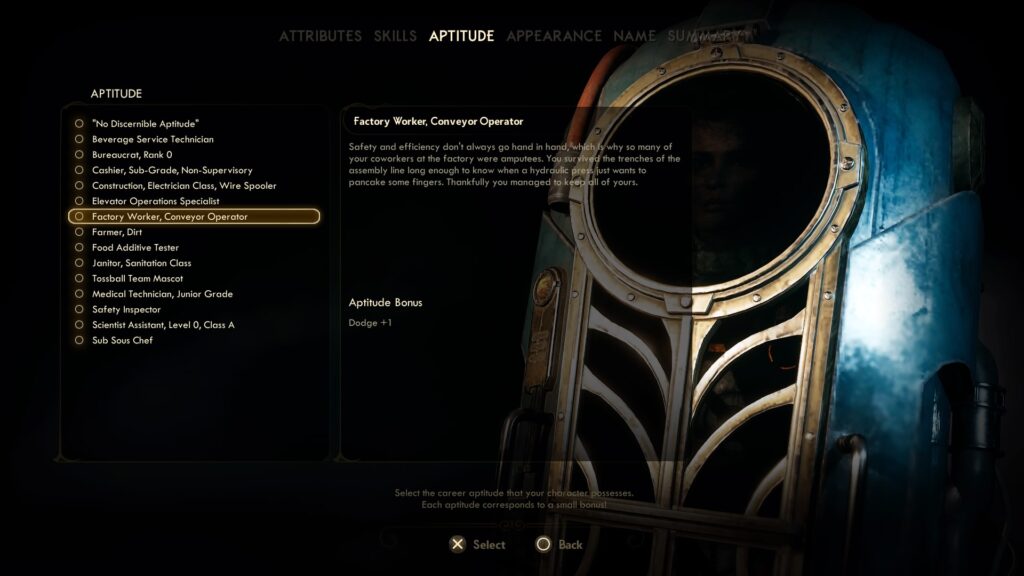
Unfortunately, the visual customization is fairly lackluster. This is especially apparent when it comes to the hairstyles. It seems like Obsidian didn’t want to animate long hair, because it doesn’t exist in The Outer Worlds. As you’ve probably seen from people complaining online, its not really possible to make a “girly” looking female character, and it doesn’t help that many of the makeup options are just plain bizarre. None of that ultimately matters though, because The Outer Worlds is a first-person RPG and you’ll be covered in armor and helmets soon enough anyway.
The rather bland character creator extends to the main game’s character designs, though. Simply put, most of the game’s NPCs look very generic. That’s fine for townsfolk and vendors, but even main characters look like they were built within the game’s character editor. Its clear that Obsidian built some basic templates and stuck with them, as you’ll quickly notice that your companions’ hairstyles and many facial features were just reused from the game’s character creator options. It results in a lot of characters and NPCs looking pretty similar and uninteresting.
Once you’re done making your character, you’ll be thrown into a rather lengthy tutorial map that involves fixing a dispute between a struggling town and a group of deserters that decided they didn’t want to work themselves into an early grave in a fish canning factory with negligent safety protocols. This will eventually lead to you gaining access to your ship, The Unreliable.
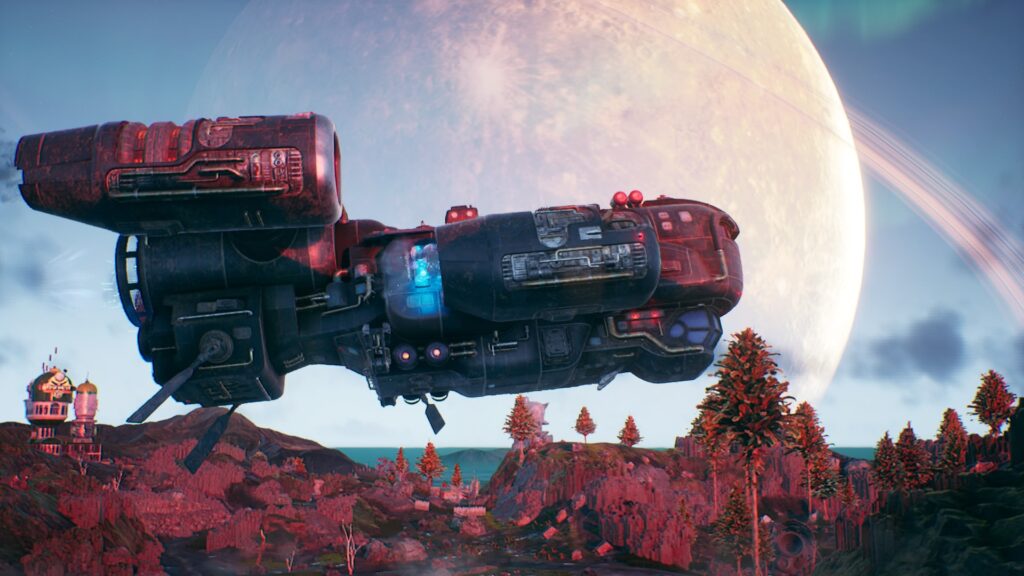
The Unreliable will serve as your mobile hub in The Outer Worlds. From there you can travel to the various worlds, space stations, and other points of interests that comprise the Halcyon colonies. Each planet in the game is essentially a large, square map with a few towns or other instanced areas to visit. It also really pays to travel off the main path, because you’ll find tons of hidden areas or zones not otherwise important to your overall goals that may still contain useful items and loot.
The game’s various locations are all visually interesting, with an aesthetic that blends pulp sci-fi serials of the ’50s with some Wild West design elements, hence the obvious comparisons to Firefly. Environments range from rundown frontier towns comprised of prefab shelters, to lush tropical alien worlds full of exotic wildlife. The Outer Worlds is a very colorful game, as even the dirty and unitarian design of a starship like the Groundbreaker has a vibrant market full of bright neon signs and equally eccentric people.
Sadly, the console versions took a real visual hit. I reviewed the game on PS4, and there’s lots of mediocre texture work and effects scattered throughout the game. Draw distance and texture pop-in are very noticeable on the larger maps in the game. There’s also some sort of filter that makes the PS4 version look a bit fuzzy and blurry. The framerate stays pretty consistent, though it does occasionally stutter a bit. Loading times in particular are quite tedious on the PS4, and can regularly take upwards of 30 seconds.
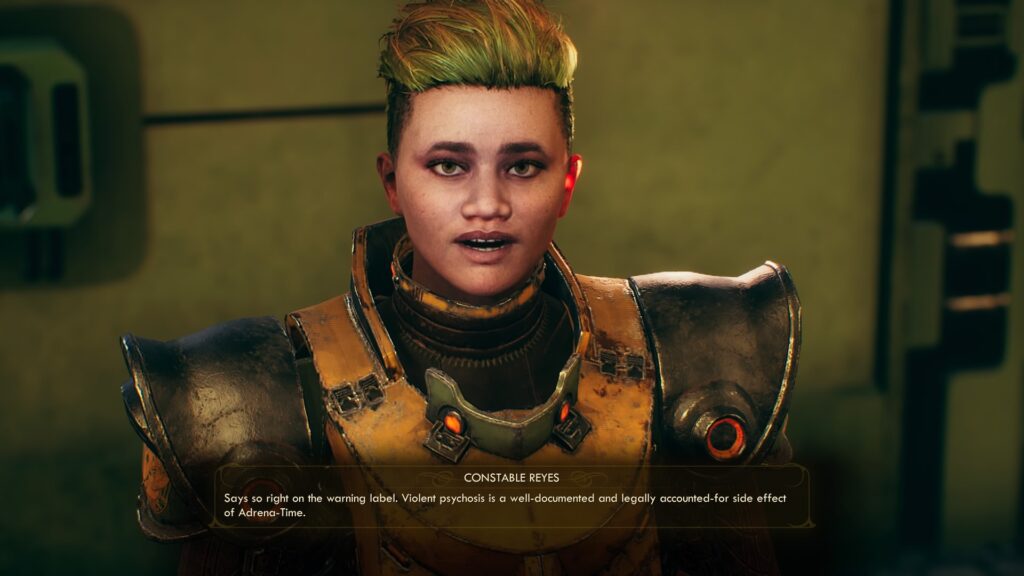
The game’s writing is generally well-delivered, and the overall tone hovers between serious and darkly comedic. While The Outer Worlds certainly does feature its share of serious and grim situations, there’s also plenty of sarcastic humor that pokes fun at corporate culture when its taken to its most logical, unregulated extreme. Even soldiers and guards will tell you corporate slogans during dialog as they try to shill products for their uncaring overlords, which is no-doubt expressly stated as something they must do in their contracts.
While the writing in general is fairly solid, your companions are especially interesting, particularly Parvati and Vicar Max. Each companion has personal quest chains you can help them with, and they’ll often interject in dialog. In fact, having the right companion with you at the right time and occasionally make conversations easier, or open up new dialog options. Your companions also grant passive stat bonuses for being in your party that can further dictate which ones you want to bring along for a specific quest or mission.
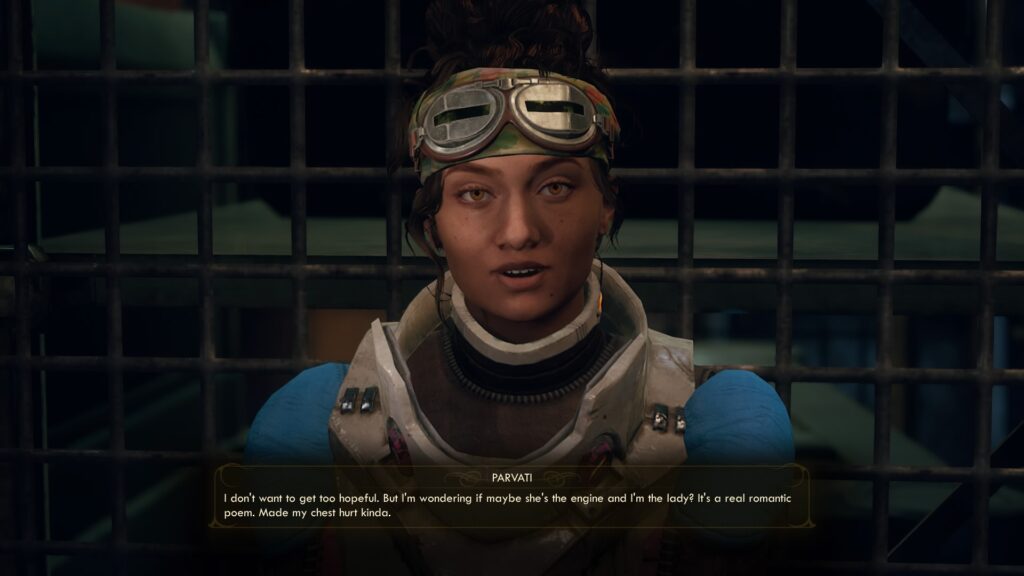
The conversations are a big highlight of the game’s RPG elements, and you are given quite a bit a freedom to lie, persuade, and intimidate your way through dialog, assuming you have the relevant stats.
The Halcyon colonies are populated with almost a dozen factions, ranging from different corporations, to rebel organizations, to neutral parties that just want to be left alone. Most of the factions generally hate each other and are often at odds in some of the game’s quests, so siding with one or the other can shift your reputation.
The writing and story is further enhanced by the fairly competent voice work, even from minor NPCs. Unfortunately, the game’s facial animations and lip syncing leave a lot to be desired, especially on the PS4 version I played.
Apparently this isn’t as big an issue in the PC version, but wonky animations still exist. There are times where the facial animations get so bad it actually looks like the left half of a character’s face is paralyzed. At first I thought it was the game’s attempt at rendering smirks, but sometimes it’ll happen in conversations where it doesn’t really make sense.
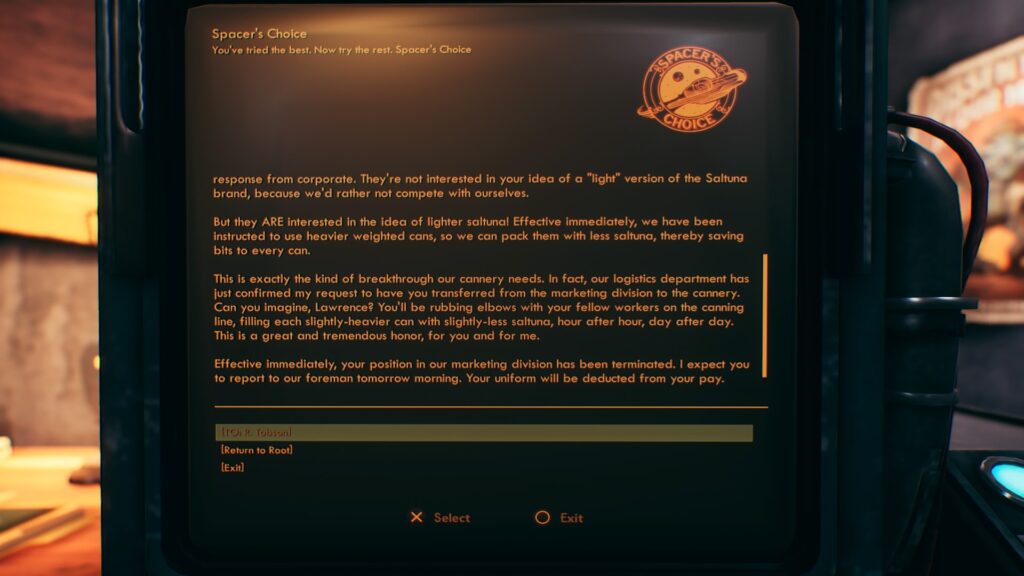
Sadly, the text throughout the game is pretty damn tiny, and there’s no way to make it larger. If you have poor eyesight and are playing the game on a console a good distance away, this can be especially annoying given how much text there is in The Outer Worlds.
The world is littered with computer terminals, journals, signs, and posters that you can read to further learn about the game’s lore and setting, most of which can be fairly hilarious. The game really hammers you with the message of “unregulated corporations are bad.” There is even a corporate-funded religion designed to keep the populace in check by reminding them that working to serve the Board is their only real purpose in life.
Which is why its especially funny that the PC version of The Outer Worlds is an Epic Games Store exclusive. The game even openly mocks product exclusivity at every turn, with jabs about the corporations all having their own branded products sold by licensed buyers and vending machines.
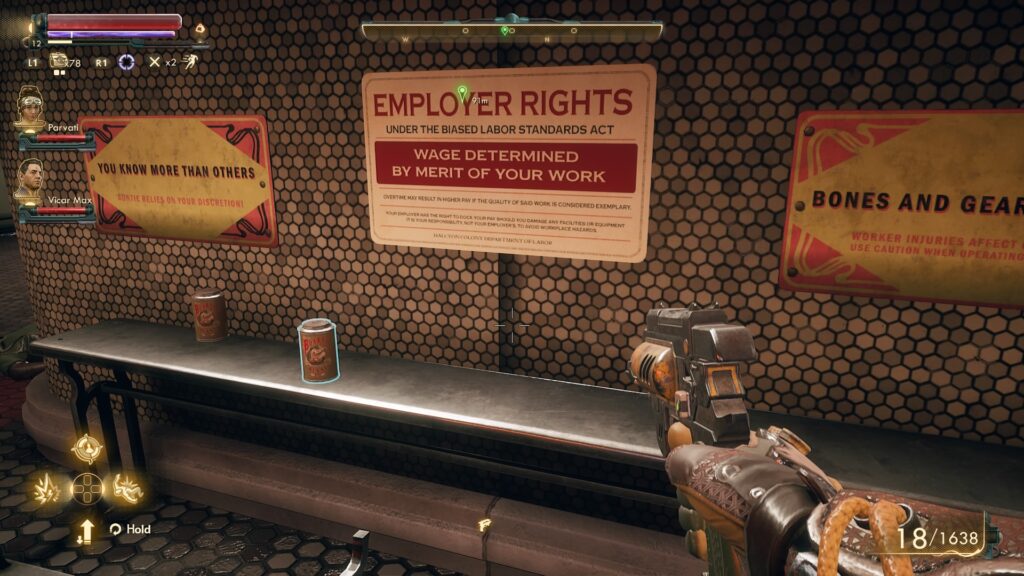
PC gamers were pointing out the irony of a game about crappy and anti-consumer corporate decisions being subject to a crappy and anti-consumer corporate deal, and the irony becomes even more palpable once you actually play the game.
While the game layers the “unregulated corporatism bad” message pretty thick, that isn’t to say that the enemies of the Board are that all great either. The game’s world and factions are all pretty crappy in their own ways. Players that sympathize with the deserters in the game’s first big quest arc are in for a rather disturbing twist that has creepy long-term implications.
The game’s character progression comes in the form of skills and perks. Each skill governs a specific playstyle, and has two or three sub-skills. For example, the Ranged Weapons skill contains Hand Guns, Long Guns, and Heavy Weapons, while Stealth contains Sneak, Hack, and Lockpick. Every time you level up you get 10 skill points to distribute how you see fit. Initially, spending a skill point in a specific skill with increase all the sub-skills, but once you reach 50 in that sub-skill you’ll need to start devoting points to them individually.
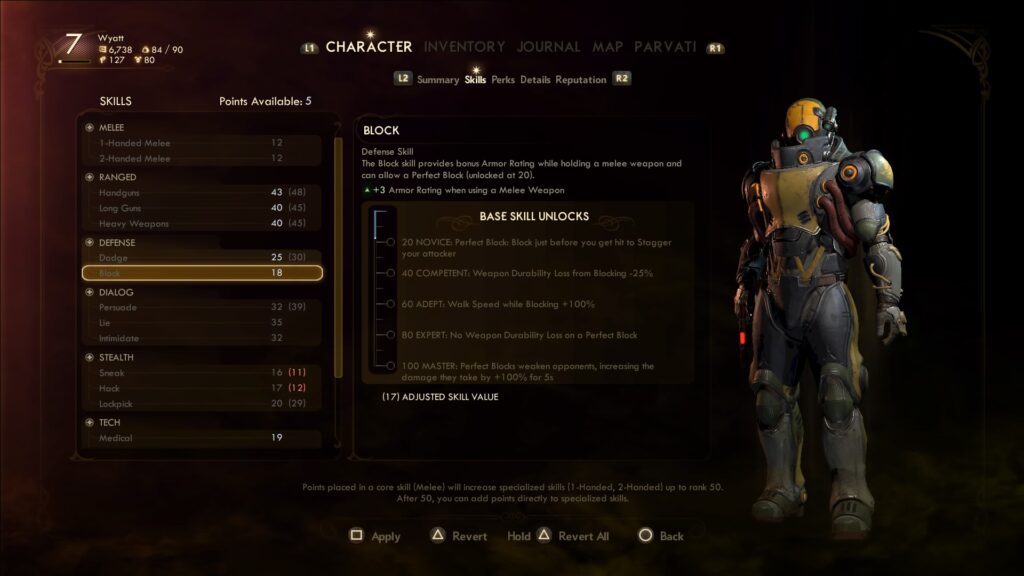
You get new passive bonuses for each 20 points you have in a specific sub-skill, and some of these can be very significant, like unlocking the ability to pickpocket, or unlocking additional slots for your inhaler that add bonus effects when you heal.
Every few levels will give you a perk point. The game has three tiers of perks, each of which contain about a dozen of them. To unlock a new tier, you need to have at least five perks from the previous tier. Perks are fairly significant bonuses that can further enhance your playstyle, like increasing your dialog skills, improving the recharge rate of your companion abilities, improving critical chances with specific types of weapons, and so on.
There’s another way to get even more perk points. Throughout your journey, you’ll occasionally get the chance to accept a negative quirk in exchange for a free perk point. Say you’ve been caught stealing or digging into areas you shouldn’t be a few too many times. If this particular quirk appears, you can choose to take a permeant debuff to your persuasion skills for a free perk point. On the basic difficulty settings I never really felt the need to take on these quirks to get extra perks, but I can see the benefits of the system.
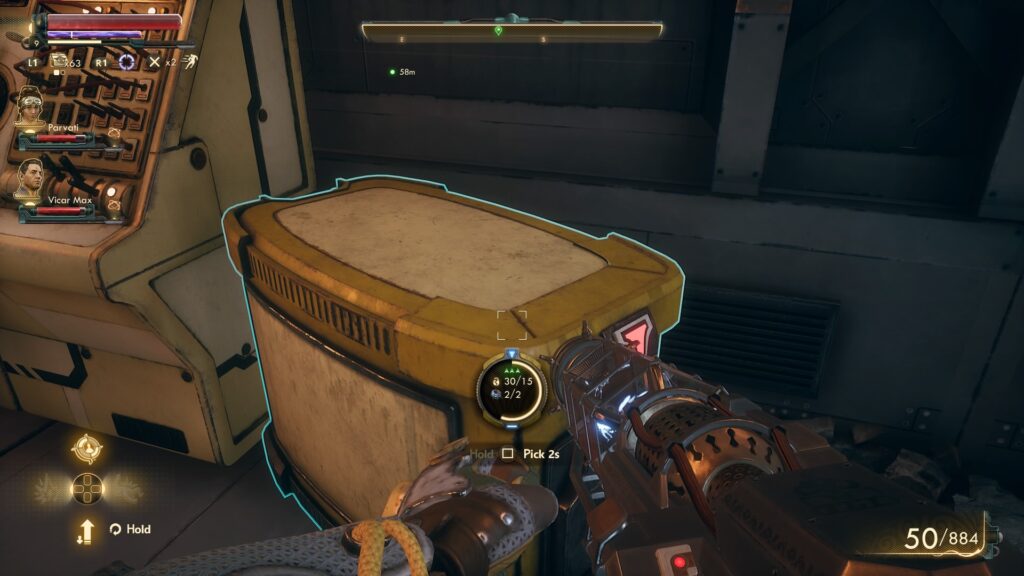
Overall, the character progression has a fair amount of depth, and gives you plenty of ways to play. While you will be engaging in combat no matter what, you do have the freedom to defuse a fair number of situations with your persuasion skills, or simply sneak around and silently take down enemies one at a time if you want to take a more roguish approach.
You can upgrade more than just yourself by tweaking your gear at a workbench. The most basic way of improving your gear is by equipping mods. All gear, from guns to armor, will have slots for mods. A rifle’s slots might consist of your sights and ammo type, while a melee weapon will have slots for its grip and the actual pointy bit. Mods are permanent and will be destroyed when you choose to replace one, but they are so plentiful that losing them isn’t a big deal.
If you have the proper technical skills, you can also tinker with your gear, meaning you spend money to increase the gear’s base stats. This allows you to really extend the life of your favorite gear if you don’t find anything better that really catches your attention.
While the modding and tinkering is a nice touch, its just a shame that the modifications don’t extend to the gear’s design. At most you’ll get a new scope, or if you swap a gun’s ammo type the lights on your firearm might change colors. The vast majority of mods cause no real visual change.
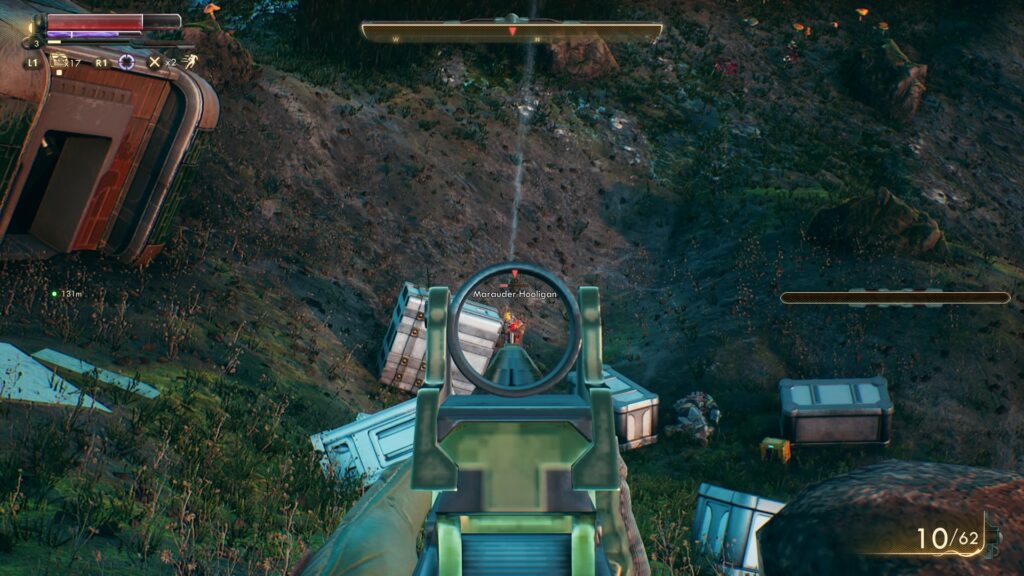
When it does come down to combat, The Outer Worlds is about what you’d expect from a shooter-RPG. Most of the guns have some fairly decent sound assets and a good amount of recoil, so they feel moderately satisfying to shoot.
The melee weapons feel a bit more floaty though, and don’t really have the feeling of impact I wish they would. The game does suffer somewhat from the same bullet sponge syndrome that many shooter-RPGs have, though its nowhere near as bad as, say, Borderlands.
Due to being in cryo sleep for over 70 years, your character has the ability to perceive time differently than everyone else. In gameplay terms, this lets you slow time to a crawl to more precisely line up shots. For all intents and purposes, this is The Outer Worlds‘ non-copyright infringing version of V.A.T.S., and you can even target individual body parts to inflict status effects.
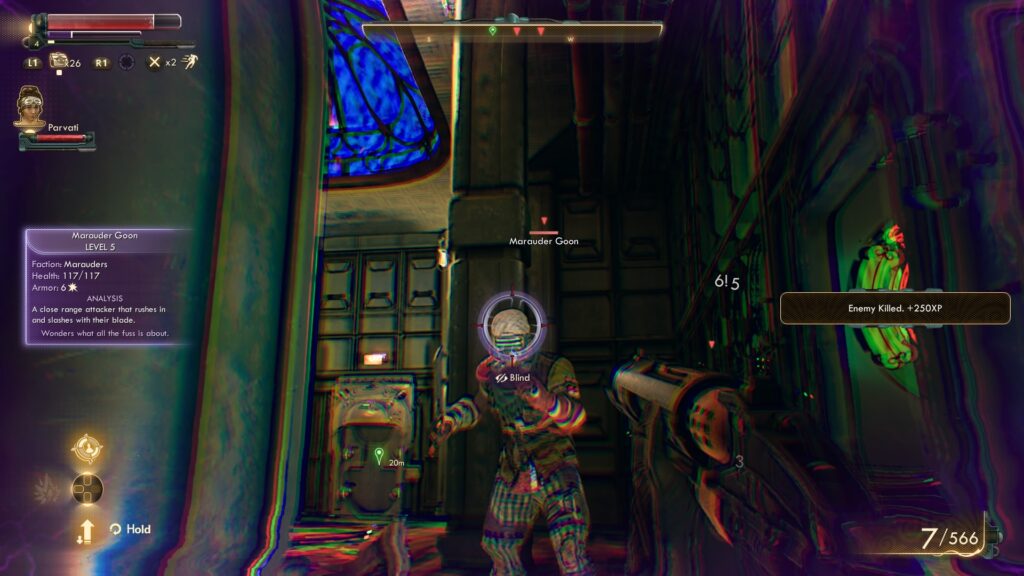
Your interaction with your companions in combat is limited to very basic commands, like directing them to focus their attacks on a specific enemy. Each companion also has a cooldown-based special skill, like Max’s ability to deal damage and knock an enemy down with a shotgun blast. While these abilities are useful, they are also accompanied by a short cutscene that can get old after a while.
You can set some basic combat behaviors for your companions, but you ultimately don’t have any real control over them in battle. Also, the AI in general is pretty atrocious. Your companions will die quite frequently in longer engagements, and enemies aren’t particularly smart or capable of focusing their attention on the juiciest target. Sniping enemies from long range is hilariously effective, and can be easily exploited.
One of the most annoying aspects of combat is the lack of a proper weapon wheel or hotkey system. Well, there is a weapon wheel, but you can only hold four weapons. The game also drowns you in all kinds of consumable items, but unless you put points into Medical to unlock extra slots for your inhaler, there’s no way to easily access all those consumables in battle.
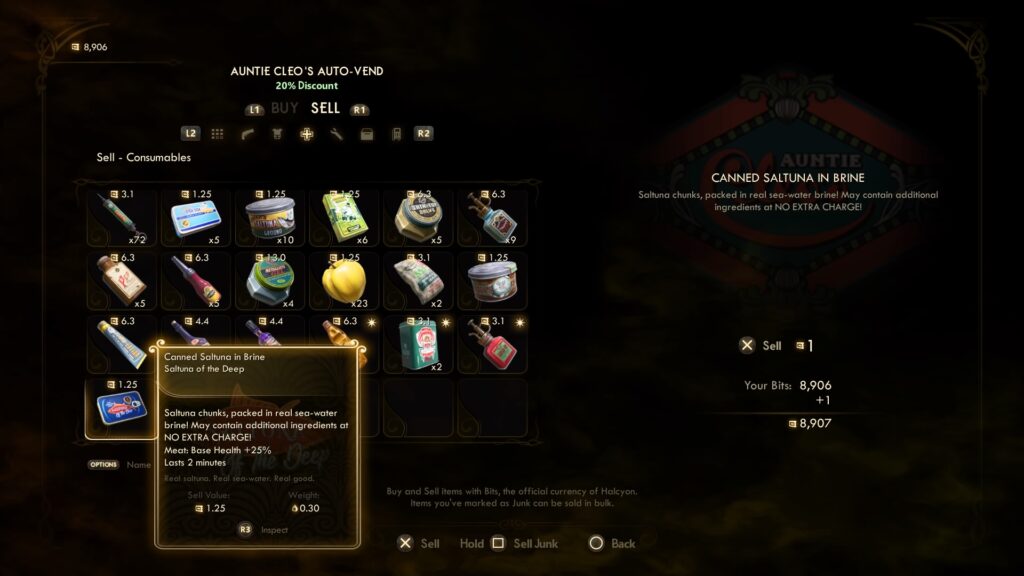
If you want a challenge from The Outer Worlds, you’ll definitely want to crank the difficulty settings up. The standard and mid-level settings aren’t particularly challenging, due in no small part to the easily exploitable AI, sheer effectiveness of longer range guns, and the game’s tendency to throw barrels full of useful items and loot at you. Luckily, the truly hardened gamers out there have the Supernova difficulty, which adds actual survival elements like the need to eat and drink.
Many other sites reported the game’s rather short runtime before release, and they aren’t wrong. The Outer Worlds is fairly lean for a AAA RPG, and if you just focus on the main story, it probably won’t take you more than a weekend to blitz through everything. For the average gamer that isn’t a completionist but still wants to see most of the game’s major side content, you’ll probably finish The Outer Worlds in around 35 hours.
My overall thoughts on The Outer Worlds are very conflicted. As you’ve probably seen throughout this review, I haven’t been overly negative. On the other hand, I haven’t been overly positive either. Simply put, while The Outer Worlds is competent enough at everything it sets out to do, it also doesn’t particularly excel at anything.
The RPG elements are decent enough, the conversation system has its fair share of options, the story and writing are fairly solid, the world is interesting, and the combat is serviceable, but even with all that in mind the game never actually wowed me. I was engaged, but rarely truly excited about what will happen next in the story, or what loot I might find just over the next hill.
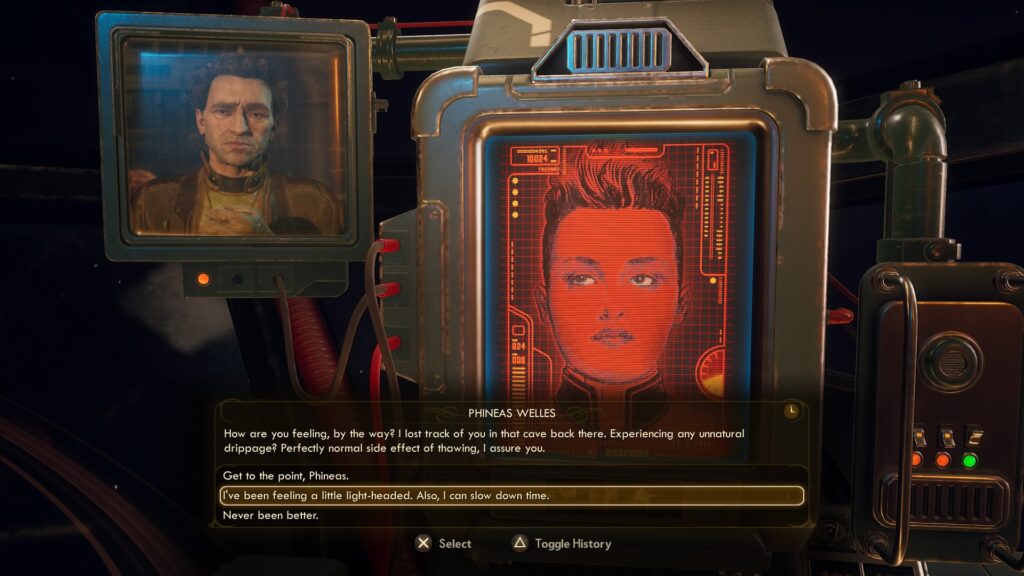
Maybe I’m just asking for things that the game never intended to be, but I can’t help but wish that the RPG elements were a bit deeper, or that the combat wasn’t as limited in terms of how many guns and items you can have equipped at once, or that you had more control over your companions besides just issuing a simple “focus on this enemy” command and occasionally buying a perk for them.
I’d be lying if I said I didn’t find a decent amount of things to like in The Outer Worlds, but at the same time I can’t help but feel like it has the potential to be so much better. I don’t hate the game, but I also don’t feel like its the big next generation Fallout: New Vegas that a lot of people were hoping for. If you temper your expectations and go in expecting a fairly competent first-person RPG that never really feels exceptional, then you’ll still probably enjoy yourself.
The Outer Worlds was reviewed on PlayStation 4 using a review copy provided by Private Division. You can find additional information about Niche Gamer’s review/ethics policy here.